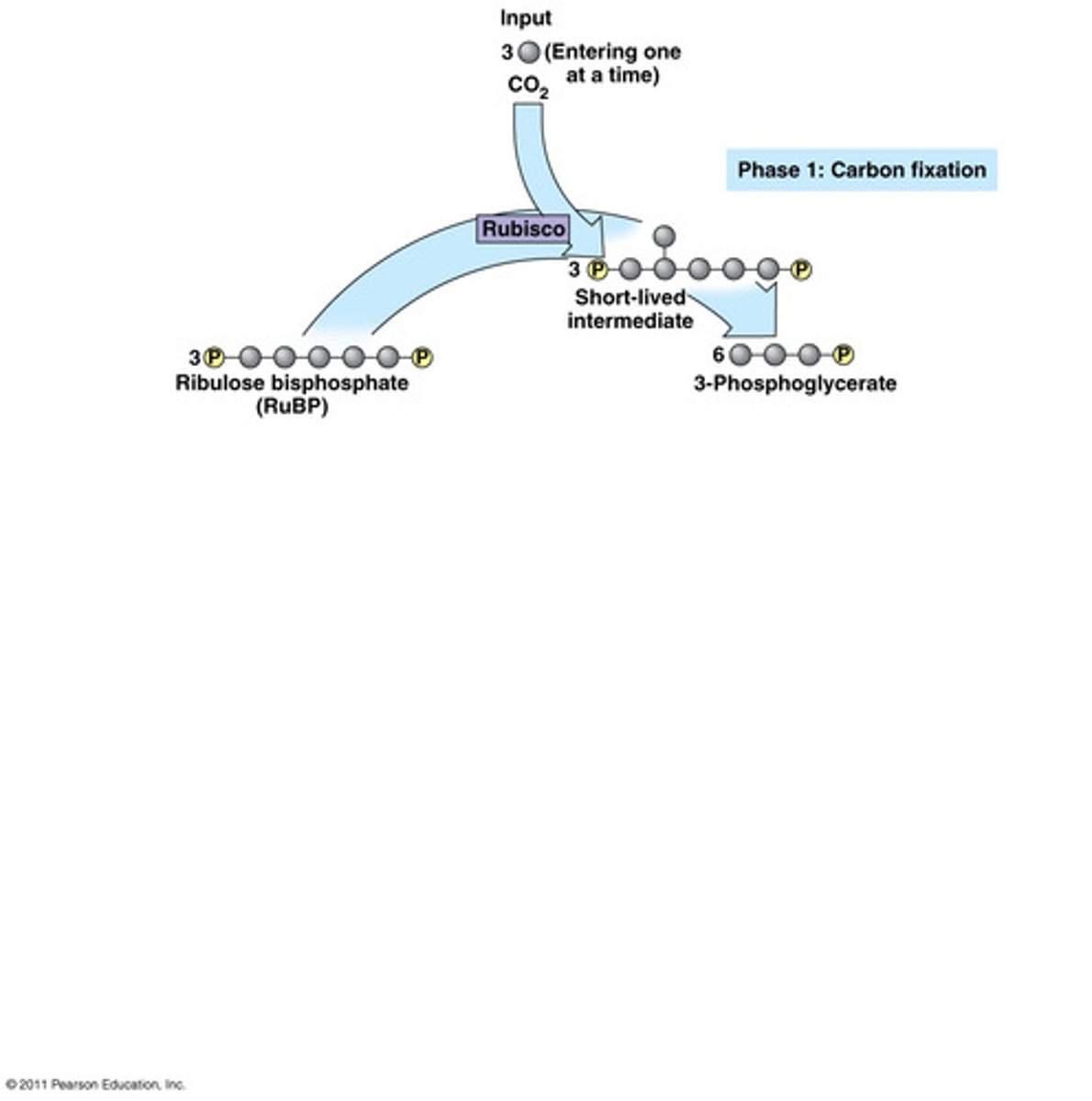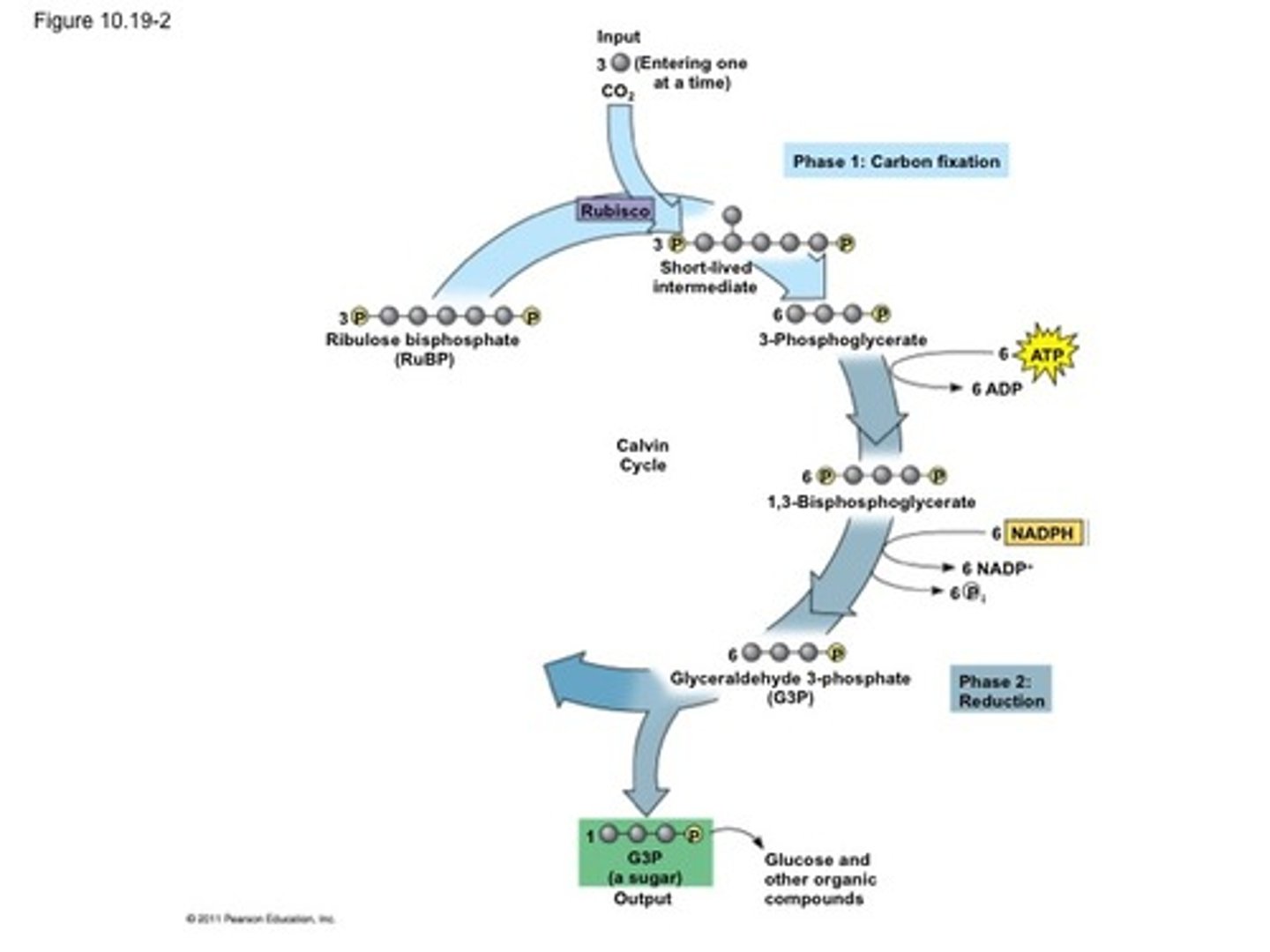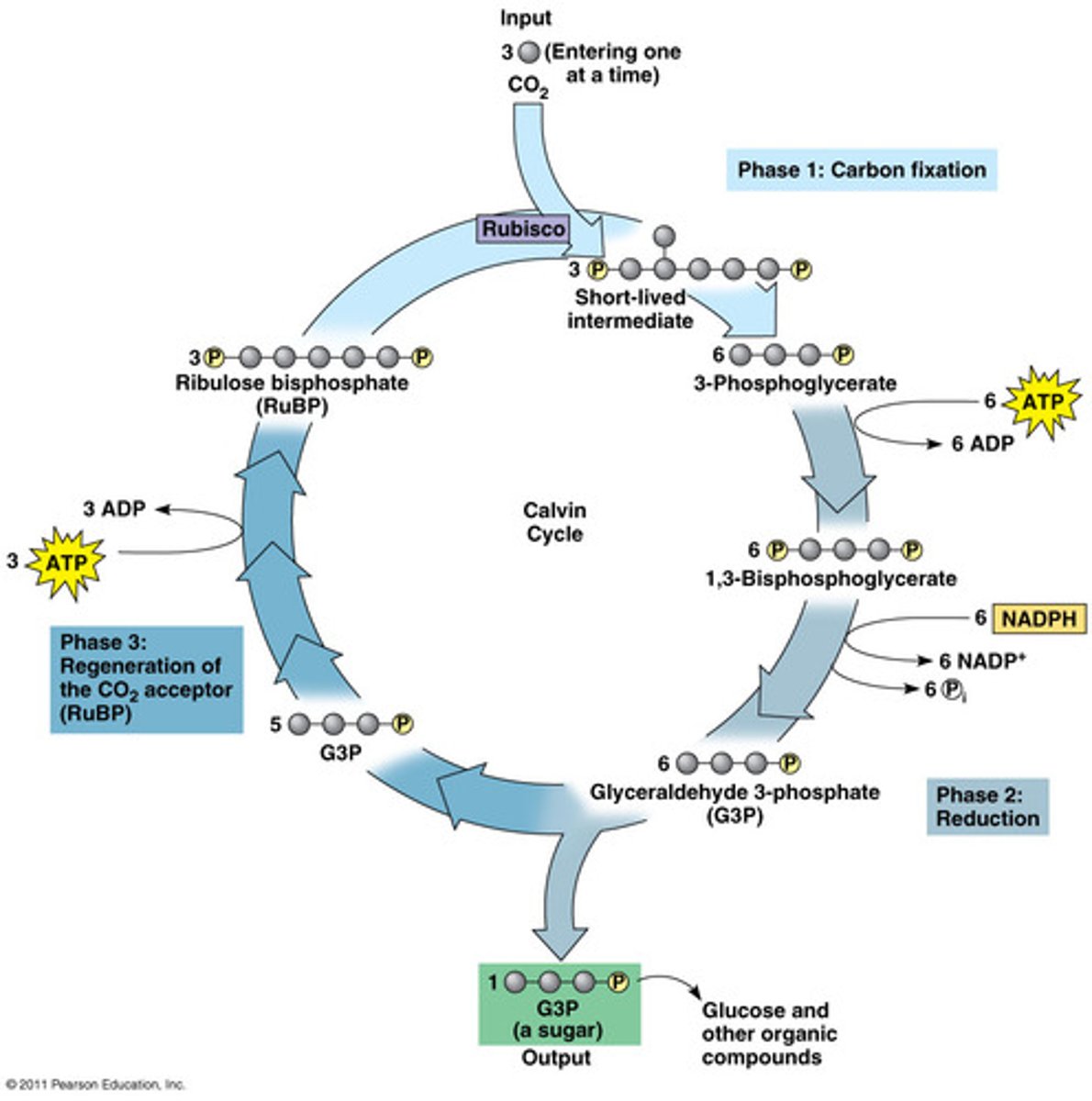Calvin Cycle and C3, C4, and CAM plants
1/29
There's no tags or description
Looks like no tags are added yet.
Name | Mastery | Learn | Test | Matching | Spaced |
|---|
No study sessions yet.
30 Terms
catabolic; anabolic
The citric acid cycle is _______________, oxidizing acetyl coA and using the energy to synthesize ATP, while the Calvin cycle is ____________, building carbohydrates from smaller molecules and consuming energy.
CO2; sugar
Carbon enters the Calvin cycle in the form of _______ and leaves in the form of _________.
ATP; NADPH
The Calvin cycle spends ______ as an energy source and consumes __________ as reducing power for adding high energy electrons to make the sugar.
glyceraldehyde 3-phosphate
3-carbon sugar that is produced directly from the Calvin cycle
carbon fixation, reduction, regeneration
What are the 3 phases of the Calvin cycle?
stroma
Where does the Calvin cycle take place?
inputs: CO2, ATP, NADPH
outputs: G3P, ADP, NADP+
inputs and outputs of Calvin cycle
Carbon fixation.
The Calvin cycle incorporates each CO2 molecule, one at a time, by attaching it to a 5 carbon sugar named ribulose diphosphate (RuBP). Rubisco helps catalyze this attachment. The product of the reaction is a 6-carbon intermediate that is short-lived because it is so energetically unstable that it immediately splits in half, forming 2 molecules of 3-phosphoglycerate (for each CO2 fixed)
Step 1 Calvin Cycle

rubisco
the enzyme that catalyzes the attachment of a CO2 molecule to RuBP; most abundant protein in chloroplasts and is also thought to be the most abundant protein on earth
Reduction.
Each molecule of 3-phosphoglycerate receives an additional phosphate group from ATP, becoming 1,3-biphosphoglycerate. Next, a pair of electrons donated loses a phosphate group in the process, becoming glyceraldehyde 3-phosphate (G3P). Specifically, the electrons from NADPH reduce a carboxyl group on 1,3-biphosphoglycerate to the aldehyde group of G3P, which stores more potential energy. For every 3 molecules of CO2, 6 molecules of G3P are formed. Only one molecule of this 3 carbon sugar can be counted as a net gain of carbohydrate and be used by the plant cell. The other 5 molecules must be recycled to regenerate 3 molecules of RuBP
Step 2 Calvin Cycle

Regeneration.
In a complex series of reactions, the carbon skeletons of 5 molecules of G3P are rearranged by the last steps of the Calvin cycle into the 3 molecules of RuBP. To accomplish this, the cycle spends 3 more molecules of ATP. The RuBP is now prepared to receive CO2 again, and the cycle continues
Step 3 Calvin Cycle

A G3P molecule contains three fixed carbon atoms, so it takes two G3Ps to build a six-carbon glucose molecule. It would take six turns of the cycle, or 6 CO2, 18 ATP, and 12 NADPH to produce one glucose molecule
How many turns does it take to make one glucose molecule?
3; 9; 6
To synthesize one glucose molecule, the Calvin cycle uses _____ molecules of CO2, _____ molecules of ATP, and _____ molecules of NADPH.
B. Calvin Cycle > Krebs Cycle
Which cellular process runs faster, Calvin Cycle or Krebs Cycle
A. Calvin Cycle < Krebs Cycle
B. Calvin Cycle > Krebs Cycle
C. Calvin = Krebs Cycle
A. C3 plants
Which type of the following plants carry out the most photorespiration?
A. C3 plants
B. C4 plants
C. CAM plants
stomata
pores on the leaf surface that allows for gas exchange; main avenues of transpiration (evaporative loss of water from leaves)
close
On a hot, dry day, most plants ______ their stomata, a response that conserves water but also reduces CO2 levels
C3 plant
a plant that uses the Calvin cycle for the initial steps that incorporate CO2 into organic material, forming a 3-carbon compound as the first stable intermediate. Make up the majority of plants (80%)
Ex: rice, wheat, soybeans
photorespiration
a metabolic pathway that consumes oxygen and ATP, releases CO2, and decreases photosynthetic output. Generally occurs in hot, dry, bright days, when stomata close and the O2/CO2 ratio in the leaf increases, favoring the binding of O2 rather than CO2 by rubisco. The process is energetically costly.
C4 plants
a plant in which the Calvin cycle is preceded by reactions that incorporate CO2 into a 4-carbon compound, the end product of which supplies CO2 for the Calvin cycle
Ex: sugarcane, corn
bundle sheath cells and mesophyll cells
In C4 plants, what are the 2 distinct types of photosynthetic cells?
bundle sheath cells
a type of photosynthetic cell arranged into tightly packed sheaths around the veins of a leaf
1. In mesophyll cells, the enzyme PEP carboxylase adds CO2 to PEP, forming a 4 carbon compound called oxaloacetate
2. Oxaloacetate is then converted to a similar molecule called malate and moves into a bundle sheath cell via plasmodesmata
3. In bundle sheath cell, CO2 is released and enters the Calvin cycle. The same reaction regenerates pyruvate, which is transported to mesophyll cells. There, ATP is used to convert pyruvate to PEP, which can accept addition of another CO2, allowing the reaction cycle to continue
C4 pathway

The mesophyll cells of a C4 plant pumps CO2 into the bundle sheath cells, keeping the CO2 concentration in those cells high enough for rubisco to bind CO2 rather than O2. In this way, photosynthesis spends ATP energy to minimize photorespiration and enhance sugar production.
How does C4 plants minimize photorespiration and enhance sugar production?
stomata open during the day, best adapted to hot, sunny environments
For C4 plants, when do stomata open and what kind of environment are they most adapted to?
C4 plants; uses less water and resources. In C3 plants, binding of O2 rather than CO2 by rubisco leads to photorespiration, while C4 plants overcome this problem by concentrating CO2 in bundle sheath cells. Rising temperatures can affect levels of CO2 for C3 plants, while many C4 plants are largely unaffected by temperature.
Which is more efficient? C4 or C3 plants?
CAM plants
a plant that uses crassulacean acid metabolism, an adaptation for photosynthesis in arid conditions
Ex: cacti, pineapples
At night, CAM plants open their stomata, allowing
CO2 to diffuse into the leaves. This CO2 is fixed into oxaloacetate by PEP carboxylase (the same step used by C4 plants), then converted to malate or another type of organic acid. The organic acid is stored inside vacuoles until the next day. In the daylight, when the light reaction can supply ATP and NADPH for the Calvin cycle, the CAM plants do not open their stomata, but they can still photosynthesis. That's because the organic acids are transported out of the vacuole and broken down to release CO2, which enters the Calvin cycle. This controlled release maintains a high concentration of CO2 around rubisco
CAM pathway

In C4 plants, the initial steps of carbon fixation are separated structurally from the Calvin cycle, where as in CAM plants the two steps occur within the same cell but at separate times
What is the difference between C4 and CAM plants?
night; day; closing
CAM plants open their stomata during the _________ and close them during the ________. ___________ stomata during the day helps desert plants conserve water.